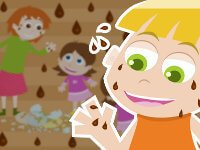The Experiments of Miss Ellis. Audio story for kids with music and sound effects.
Tap the calamus image below to get free access to our best collection of stories for children with related activities. Download it to enjoy our stories whenever you want
Advertisement
![]() Where to start? Download our free Workbook of Values, watch our animated stories and enjoy Jakhu Stories, our stories for kids app
Where to start? Download our free Workbook of Values, watch our animated stories and enjoy Jakhu Stories, our stories for kids app
Click on the image center to start the story (no Flash required now)
Wait for 5 seconds; if the story does not load, click here
Story narrated by Joe Bevilacqua and Lorie Kellog. You can read the complete story text below
Share it!
- Back to story
- All versions of this story
- Recommended resources
Text of this story
That weekend Miss Ellis handed out another of her famous experiment assignments. Her pupils loved that form of teaching, in which they themselves had to think up experiments that would aid in understanding. Many had to do with science, chemistry, but others - the most famous experiments - had to do with people and their behaviour. And on that occasion the subject was really difficult: freedom. How can one conduct an experiment on freedom? What could you show about freedom through experiments?
On their way home, the students discussed these, and other similar questions. However, they had already done a good job on other experiments, and this time was no exception. On Monday, the students returned with their ideas for an experiment, and they explained them one by one. All the ideas were very interesting but, to cut a long story short, Miss Ellis has asked me to tell you only about Amanda, Charlie, and Andrea's experiments - which she liked the most.
Amanda took out five different coloured boxes and gave them to the teacher to choose one. Miss Ellis gratefully took the pink box, and smiled. Then Amanda took out five yellow boxes, and asked Charlie to choose one. Charlie, annoyed, carelessly chose one. Miss Ellis, amused, asked Amanda what the experiment was called.
"I've called it 'Choices'." For freedom to exist you have to choose between different options. That's why Charlie was a bit annoyed, because when the boxes are all the same colour, you are not really allowed to choose. But Miss Ellis has been pleased because she got to choose the box she liked the most".
Charlie had prepared another kind of experiment, a more lively one. He chose two class members. Lucas was a bright but indecisive boy, and Paul was one of the worst students. Charlie made them go up to join Miss Ellis at the blackboard. Then he divided the class into three groups.
To the first group he said: "I'm going to ask you a difficult question. You can choose one of the three people at the blackboard to help you answer it. Whoever gets the answer right will win a big bag of sweets". Everyone in the first group chose the teacher.
Then Charlie said to the second group: "You will be asked the same question, but before we start you should know that I have given Paul a piece of paper with the question and its answer written on it". Amid the sound of complaints from the first group, the second group all chose Paul.
Then Charlie spoke to the last group: "It's your turn. What I told the second group was a lie. I gave the paper to Lucas". Amid booing and a few laughs, Paul showed that his hands were empty, and Lucas showed everyone that he did indeed have a piece of paper with the question and answer on it. And Lucas was the only one who managed to answer the difficult question correctly.
While the winners were sharing the sweets out to everyone, Charlie explained: "This experiment is called 'No Freedom Without Truth' "It shows that you can only choose freely if you know the whole truth of the situation. Groups one and two were free to choose who they wanted, but as they didn't know the full truth of the set-up, they were not really choosing freely. If they had known, then they would have chosen differently.
Andrea's experiment was very different. She had come to class with Laylow, her hamster, and some pieces of cheese and bread, to prepare a few different tests. In the first she covered a piece of cheese with a glass. And at its side she placed a piece of bread, without covering it. When she set Laylow free, the hamster went straight for the cheese, banging his nose against the glass. Laylow tried to get to the cheese for a good old while, but having no success he settled for the bread.
Andrea carried on with some similar experiments, a little cruel, but amusing, in which poor Laylow could never get to the cheese and had to choose the bread. Finally, Andrea put a lump of cheese and a lump of bread on the table, both uncovered. This time, Laylow, bored, went straight over and ate the bread.
Everyone enjoyed the experiment, and while Miss Ellis rewarded Laylow with the cheese, Andrea explained: "The experiment is called 'Limits'. It shows that, whether we know it or not, our freedom always has limits, and that these limits are not always outside ourselves. They can be inside us too, as with Laylow, who thought he would never be able to get the cheese.
Many more interesting experiments were performed that day, and maybe sometime we'll get to talk about them, but what is clear is that Miss Ellis's students ended up knowing a lot more about freedom than do many much older people.
Author.. Pedro Pablo Sacristán
Would you rather look for stories, values and characters? You can do so using links below
search our tales collection



















